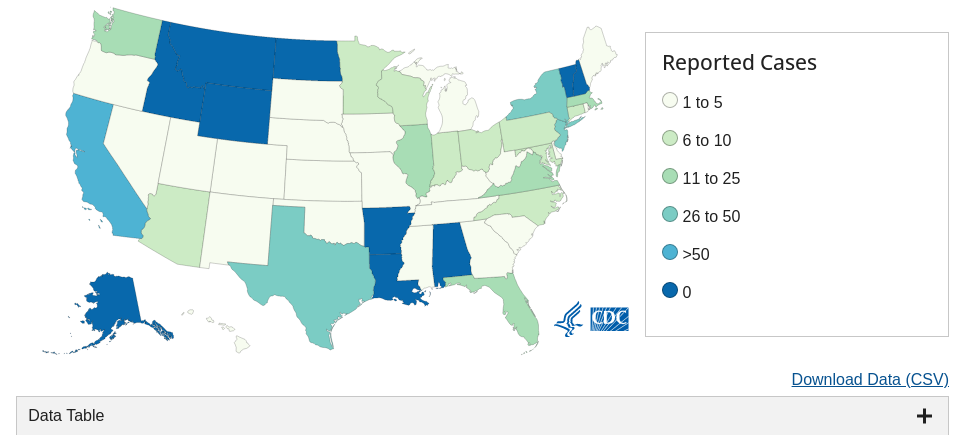National Typhoid and Paratyphoid Fever Surveillance Annual Summary, 2016
1Includes all 50 states and District of Columbia
2Paratyphoid fever is caused by Salmonella serotypes Paratyphi A, Paratyphi B, and Paratyphi C. Two distinct pathotypes of Paratyphi B are recognized; one is associated with paratyphoid fever and the other is associated with uncomplicated gastroenteritis. The two pathotypes have distinct virulence characteristics and are differentiated based on the ability to ferment tartrate. The paratyphoidal pathotype is unable to ferment tartrate and is designated serotype Paratyphi B; the nonparatyphoidal pathotype ferments tartrate and is designated serotype Paratyphi B var. L(+) tartrate+. Only those isolates laboratory-confirmed as not able to ferment tartrate are included in the annual report. Many Paratyphi B reports do not include this information; these reports are presumed to be of the non-paratyphoidal pathotype and are therefore excluded in this report.
Read an overview of the National Typhoid and Paratyphoid Fever Surveillance (NTPFS) system [PDF – 2 pages]
Demographic and Clinical Characteristics of Patients
Demographic and clinical characteristics of patients with typhoid fever and paratyphoid fever are shown in Tables 1 and 2.
- The median age of patients with typhoid fever was 23 years (range 0 – 80 years)
- The median age of patients with paratyphoid fever was 26 years (range 1 – 74 years)
- There was one death among patients with typhoid fever. There were no deaths among patients with paratyphoid fever.
International Travel
- Among the 342 typhoid fever patients whose travel histories were reported, 299 (87%) reported traveling or living outside the United States in the 30 days before illness began.
- Among the 76 paratyphoid fever patients whose travel histories were reported, 72 (95%) reported traveling or living outside the United States in the 30 days before illness began.
- Among patients reporting international travel, 264 (88%) patients with typhoid fever and 66 (92%) patients with paratyphoid fever reported travel to a single destination (Tables 3a and 3b).
- Visiting friends or relatives was the most common reason for international travel among patients with typhoid fever (55%) and paratyphoid fever (50%).
National Notifiable Diseases Surveillance System
The National Notifiable Diseases Surveillance System (NNDSS) collects and compiles reports of nationally notifiable infectious diseases, including typhoid fever. NNDSS reports can be found at www.cdc.gov/nndss/data-statistics.
The figure below presents a comparison of typhoid fever reports submitted to NTPFS and NNDSS in the past five years. Reports submitted to NNDSS can include clinically compatible cases that are epidemiologically linked to a confirmed case but are not laboratory-confirmed.
Comparisons for paratyphoid fever are not provided because, although it was nationally notifiable, it was reported under the case definition for salmonellosis during these years.
Antimicrobial Resistance
The National Antimicrobial Resistance Monitoring System (NARMS) monitors antimicrobial resistance among enteric bacteria, including Salmonella serotypes Typhi and Paratyphi A, Paratyphi B (tartrate negative), and Paratyphi C. Among Typhi, decreased susceptibility to ciprofloxacin (DSC, defined as minimum inhibitory concentration ≥0.12 µg/mL) has been associated with fluoroquinolone treatment failure. Multidrug-resistant (MDR) is defined as resistance to ampicillin, chloramphenicol, and trimethoprim-sulfamethoxazole.
Among Salmonella serotype Typhi isolated during 2016:
- 73.3% had DSC
- 9.6% were MDR
- 12.4% were resistant to three or more classes of antibiotics
- No isolates were resistant to ceftriaxone
Among Salmonella serotype Paratyphi A isolated during 2016:
- 94.6% had DSC
- No isolates were MDR
- No isolates were resistant to three or more classes of antibiotics
- No isolates were resistant to ceftriaxone
Data are available in NARMS Now, an interactive tool containing antibiotic resistance data from bacteria isolated from humans.
Outbreaks
The Foodborne Disease Outbreak Surveillance System (FDOSS) collects reports of foodborne disease outbreaks from local, state, tribal, and territorial public health agencies. The most recently published annual reports are available at www.cdc.gov/fdoss/annual-reports.
The Waterborne Disease and Outbreak Surveillance System (WBDOSS) collects reports of waterborne disease outbreaks associated with drinking water and recreational water from local, state, tribal, and territorial public health agencies. Reports are available at www.cdc.gov/healthywater/surveillance/surveillance-reports.html.
One outbreak of typhoid fever (none of paratyphoid fever) was reported in 2016. The outbreak occurred in Arizona and resulted in two illnesses.
- CDC. National Antimicrobial Resistance Monitoring System (NARMS) Now: Human Data. Atlanta, Georgia: U.S. Department of Health and Human Services, CDC. 03/30/2021. https://www.cdc.gov/narmsnow. Accessed 3/30/2021.
Centers for Disease Control and Prevention (CDC). National Typhoid and Paratyphoid Fever Surveillance Annual Report, 2016. Atlanta, Georgia: US Department of Health and Human Services, CDC, 2021

